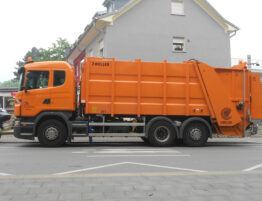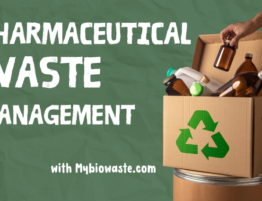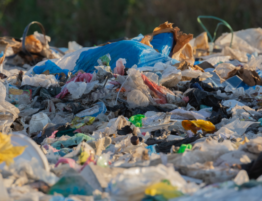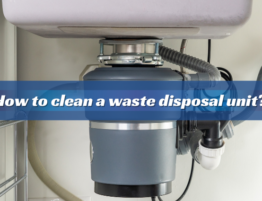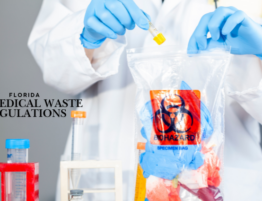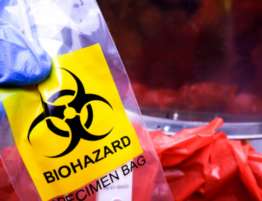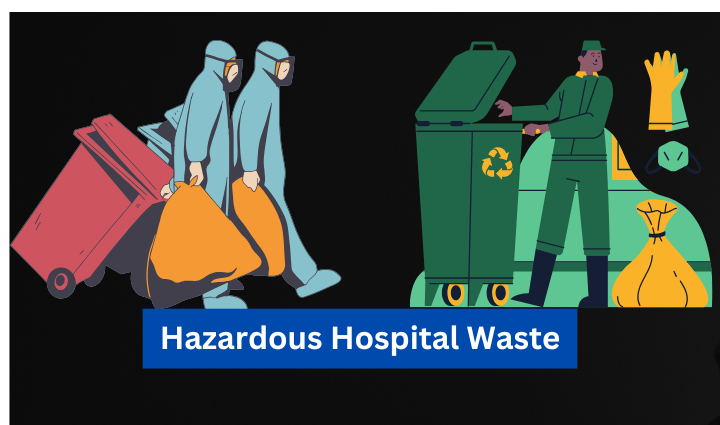
The Importance of Managing Hazardous Hospital Waste
Hospitals are at the forefront of providing life-saving care, but their operations also generate waste that poses a significant risk to both human health and the environment. Hazardous hospital waste (HHW) includes materials that can cause harm if not handled with care. From used syringes to toxic chemicals, improper disposal of hazardous waste can have serious consequences. This guide explores the different types of hazardous waste found in healthcare settings, the risks it presents, and the best practices for ensuring safe and responsible disposal.
What Is Hazardous Hospital Waste?
Hazardous hospital waste refers to waste produced by healthcare facilities that contain harmful substances, including toxic chemicals, infectious materials, or radioactive elements. These materials can include medical supplies, pharmaceuticals, blood products, and even chemicals used in diagnostic procedures. Improper management of these substances can lead to contamination and pose risks to the public, healthcare workers, and the environment.
Given the potentially dangerous nature of HHW, healthcare facilities must adhere to strict regulations and protocols to ensure its safe disposal. Effective management involves understanding the types of hazardous waste generated, the risks involved, and the proper handling procedures to mitigate those risks.
Categories of Hazardous Hospital Waste
To manage hazardous waste properly, it’s essential to understand its various types. These are generally classified based on their potential to cause harm:
1. Infectious Waste
This includes waste that contains harmful microorganisms capable of causing disease. Examples of infectious waste include used bandages, blood-soaked materials, and items contaminated with bodily fluids. Handling this type of waste improperly can lead to the spread of infections.
2. Pathological Waste
Pathological waste consists of human tissues, organs, or body parts that have been removed during surgery or autopsy. This waste must be handled with the utmost care due to its potential to spread infectious diseases.
3. Sharps Waste
Sharps include items such as needles, scalpels, and broken glass that can cause cuts or puncture injuries. They can easily carry pathogens, making their proper Sharps disposal crucial to preventing injuries and infections.
4. Pharmaceutical Waste
Expired, unused, or damaged pharmaceuticals are classified as hazardous. These drugs can pose risks through accidental ingestion, inhalation, or skin contact. The safe disposal of pharmaceutical waste prevents misuse and environmental contamination.
5. Chemical Waste
Hospitals use a variety of chemicals for sterilization, diagnostic testing, and disinfection. Many of these chemicals are toxic, corrosive, or reactive, making them hazardous if not handled properly.
6. Radioactive Waste
In some healthcare settings, radioactive materials are used for diagnostic imaging or cancer treatment. Radioactive waste must be carefully managed to minimize exposure and ensure it is safely contained.
7. General Waste
Although not classified as hazardous, some general waste items, like contaminated packaging or used medical gloves, still require appropriate disposal. These materials should be separated from hazardous waste to avoid cross-contamination.
The Risks of Improper Hazardous Hospital Waste Disposal
Improper handling or disposal of hazardous hospital waste can have serious consequences, from health risks to environmental damage. Below are some of the key risks associated with hazardous waste:
1. Health Risks to Healthcare Workers and Patients
Healthcare workers are at an increased risk of exposure to hazardous waste, especially when handling sharps or infectious materials. Accidental injuries, such as needle-stick incidents, can transmit bloodborne diseases like HIV and Hepatitis. Additionally, patients and visitors may also be exposed if hazardous waste is not properly contained.
2. Environmental Contamination
Hazardous chemicals and pharmaceuticals that are improperly disposed of can seep into water supplies or soil, affecting the local environment. For example, toxic waste can harm aquatic life or disrupt ecosystems, creating long-term ecological damage.
3. Increased Healthcare Costs
Failure to manage hazardous waste responsibly can result in costly fines, legal actions, and damage to the healthcare facility’s reputation. Moreover, inefficient waste management can increase the overall operational costs of healthcare facilities, further burdening their financial resources.
Best Practices for Managing Hazardous Hospital Waste
Effective hazardous waste management starts with the right approach to waste segregation, handling, storage, and disposal. By following best practices, healthcare facilities can reduce risks and ensure the safety of both staff and the environment.
1. Waste Segregation
One of the first steps in managing hazardous waste is proper segregation. Healthcare facilities should use clearly labeled, color-coded bins to separate hazardous waste from general waste. This prevents contamination and ensures that each type of waste is treated appropriately.
2. Personal Protective Equipment (PPE)
Healthcare workers must wear the appropriate personal protective equipment, such as gloves, masks, and gowns when handling hazardous waste. PPE is essential to protect against exposure to infectious materials, chemicals, and sharp objects.
3. Proper Storage
Hazardous waste should be stored in safe, secure containers that are leak-proof and puncture-resistant. Storage areas should be clearly labeled, and waste should be monitored regularly to prevent spills or accidents. Facilities should also ensure that waste containers are sealed and stored in designated, well-ventilated areas to minimize exposure.
4. Treatment and Disposal
Different types of hazardous waste require different disposal methods. For example:
- Infectious waste can be autoclaved (sterilized by steam) to kill pathogens before disposal.
- Pharmaceutical waste may require incineration to ensure it is destroyed.
- Chemical waste may need to be neutralized or treated before disposal to minimize harm.
- Radioactive waste should be stored in special containers and disposed of according to strict regulatory guidelines.
5. Employee Training and Awareness
Training healthcare staff on hazardous waste management is crucial. Workers should be familiar with the protocols for waste segregation, handling, and disposal. Regular training sessions and awareness campaigns help maintain a high standard of safety.
6. Compliance with Regulations
Healthcare facilities must adhere to local, national, and international regulations governing hazardous waste. These regulations are designed to protect public health and the environment. Non-compliance can result in significant fines and legal penalties, not to mention the risk of harm to workers and the community.
Innovative Technologies in Hazardous Waste Management
As technology advances, healthcare facilities are increasingly adopting innovative solutions for hazardous waste management. These technologies can help reduce waste volumes, enhance safety, and promote sustainability.
1. Waste-to-Energy Systems
Some hospitals are turning to waste-to-energy technologies that convert hazardous waste into energy. This reduces the volume of waste sent to landfills and provides a more sustainable solution by generating electricity or heat.
2. Advanced Incineration
Modern incinerators offer more efficient and environmentally friendly waste disposal by burning hazardous materials at high temperatures. These systems ensure complete destruction of harmful substances while minimizing the release of pollutants into the air.
3. Chemical Neutralization
Chemical neutralization processes are used to treat hazardous chemicals, rendering them safer for disposal. This method helps reduce the toxicity of waste before it is sent for final disposal or recycling.
Frequently Asked Questions (FAQ)
1. What is considered hazardous hospital waste?
Hazardous hospital waste includes infectious materials, pharmaceutical waste, pathological waste, sharps, chemicals, and radioactive materials that pose a significant risk to health, safety, or the environment.
2. How can healthcare facilities reduce hazardous waste?
By optimizing the use of materials, reducing disposable items, recycling non-contaminated waste, and implementing efficient waste management protocols, healthcare facilities can significantly reduce their hazardous waste output.
3. How should pharmaceutical waste be disposed of?
Pharmaceutical waste should be segregated and disposed of through incineration or other approved disposal methods to prevent contamination, misuse, or environmental harm.
4. What are the risks of improper hazardous waste disposal?
Improper disposal can lead to health risks such as infections and injuries, environmental contamination, and legal or financial consequences for healthcare providers.
5. Can hazardous hospital waste be recycled?
In some cases, recyclable materials such as plastics or metals can be separated from hazardous waste and processed after proper sterilization or treatment.
Final Thoughts
Hazardous hospital waste is an unavoidable byproduct of healthcare activities, but it doesn’t have to be a threat. By implementing safe management practices, healthcare facilities can minimize the risks associated with hazardous waste, protect workers and patients, and reduce environmental impacts. From adopting the latest technologies to ensuring comprehensive staff training, there are numerous ways to handle hazardous hospital waste responsibly.
Ultimately, safe waste management practices are an investment in both public health and the planet’s future. By committing to these practices, healthcare facilities can play a pivotal role in maintaining a cleaner, safer environment for everyone.

